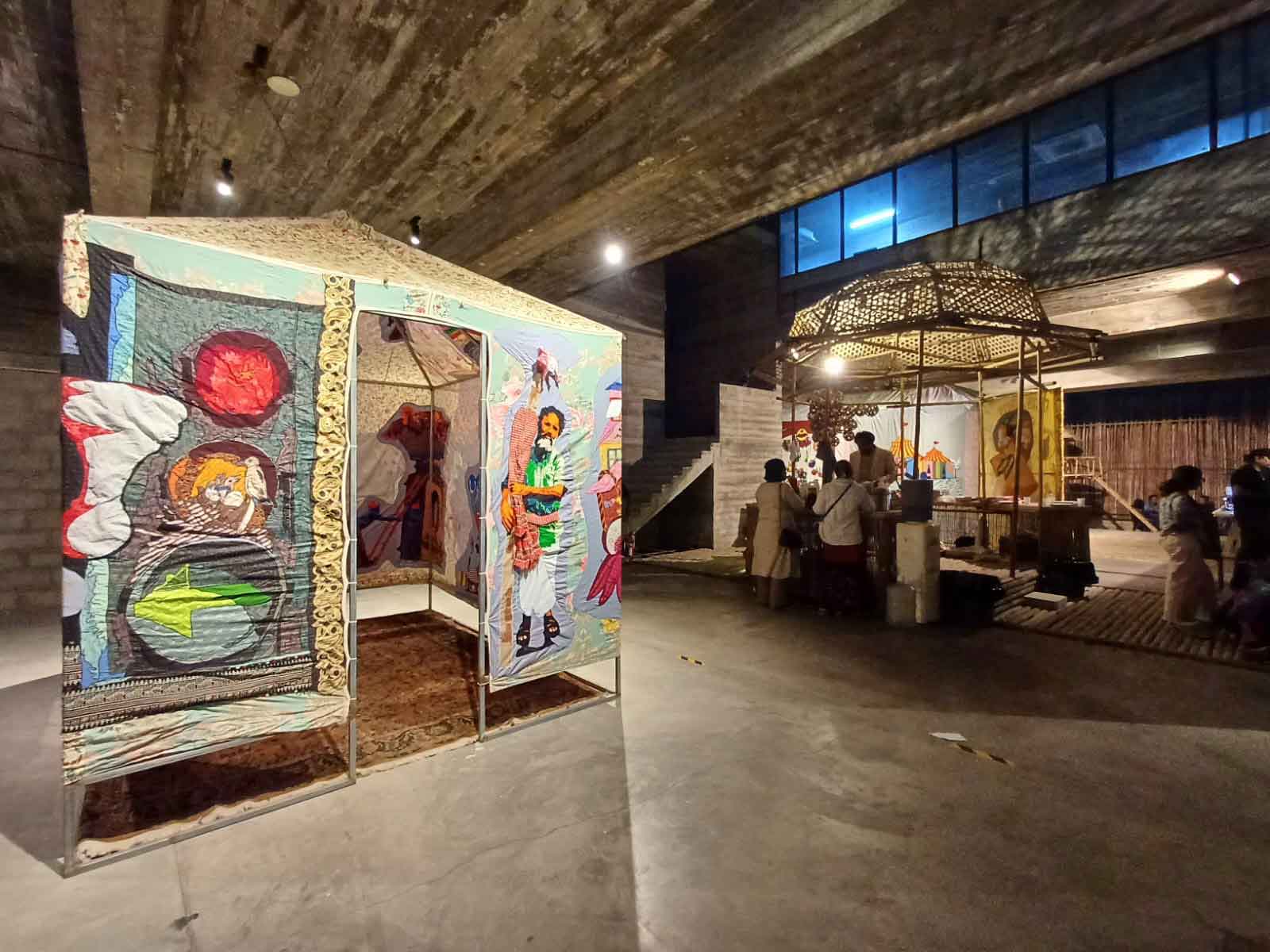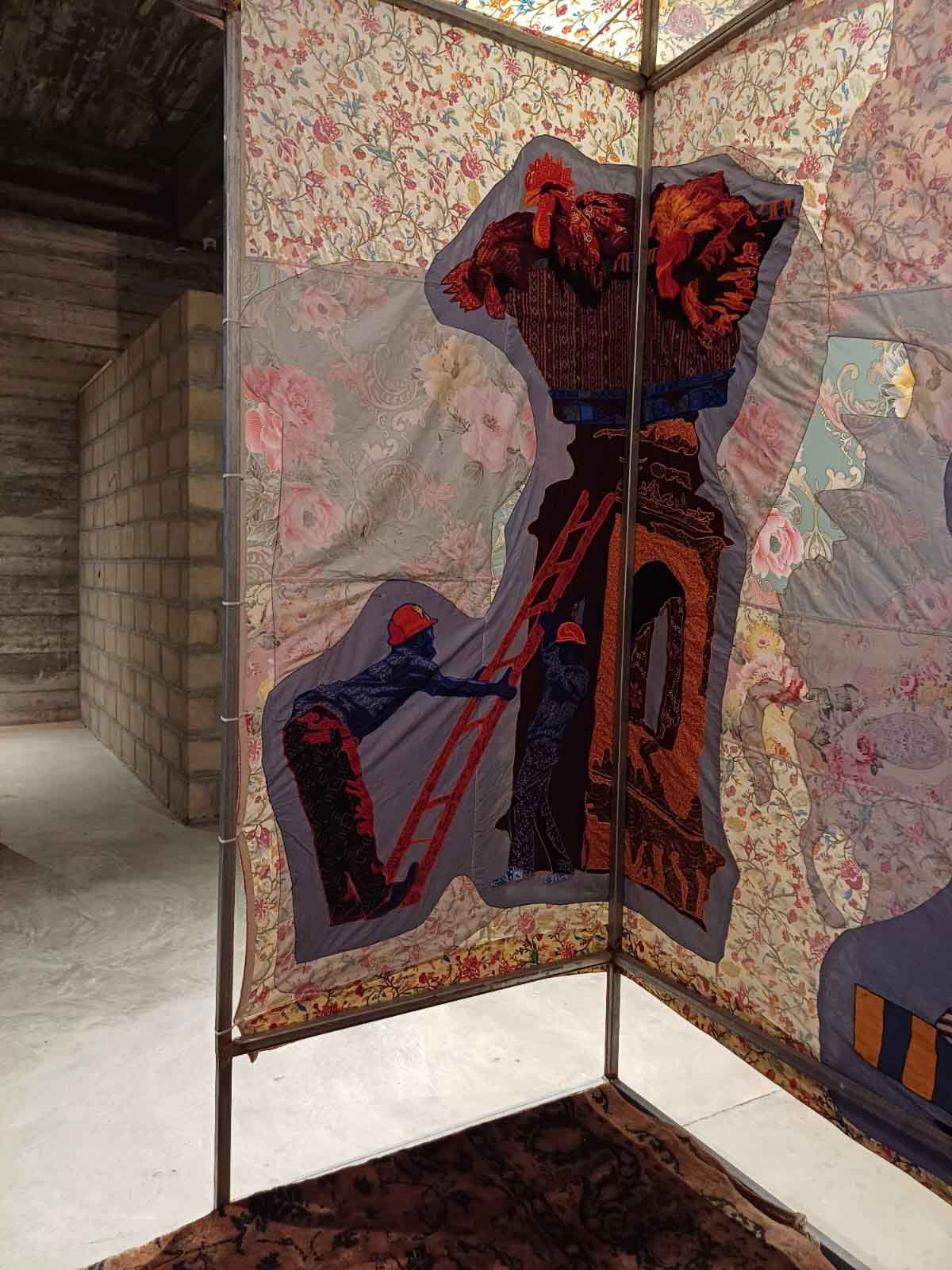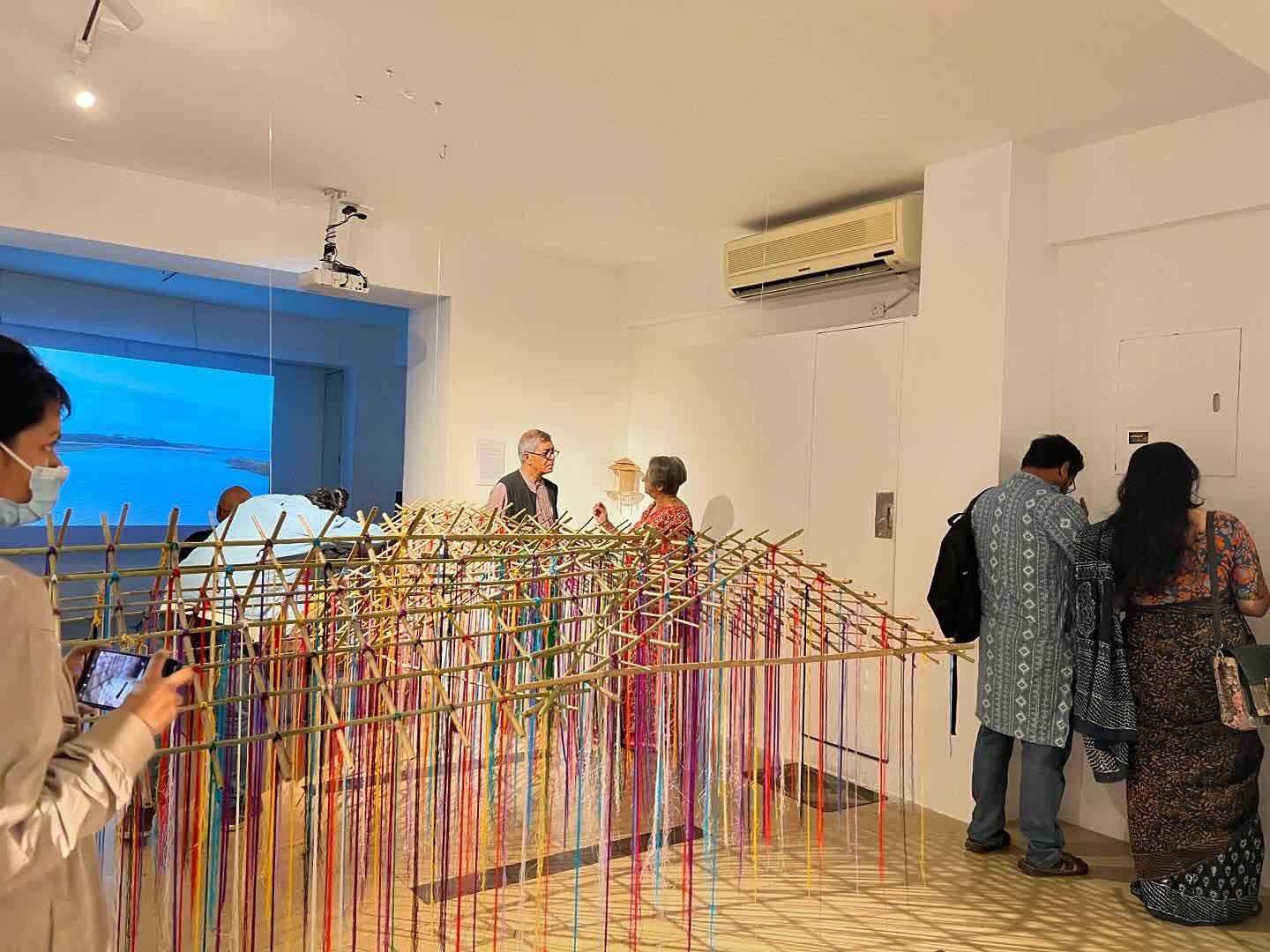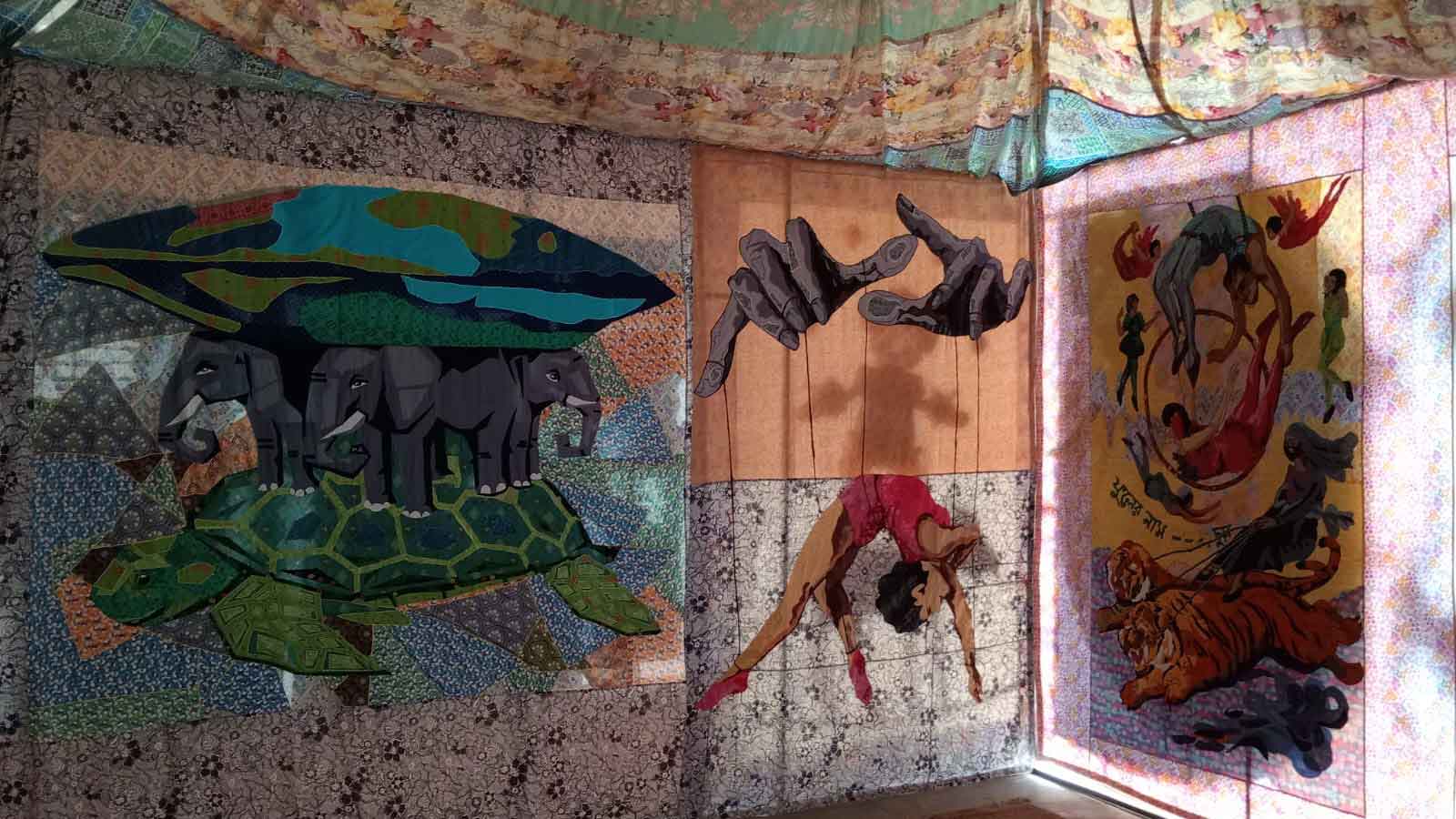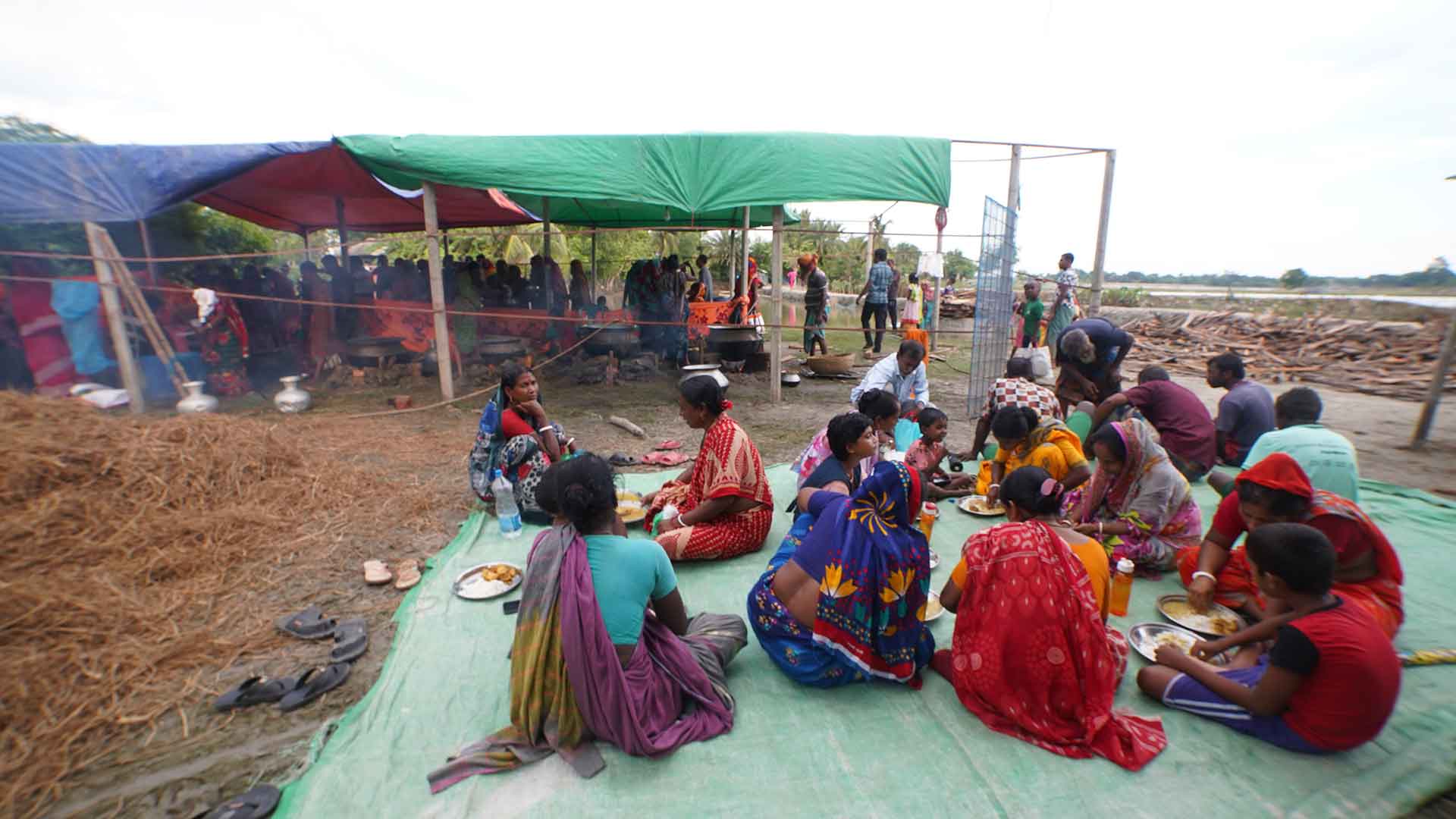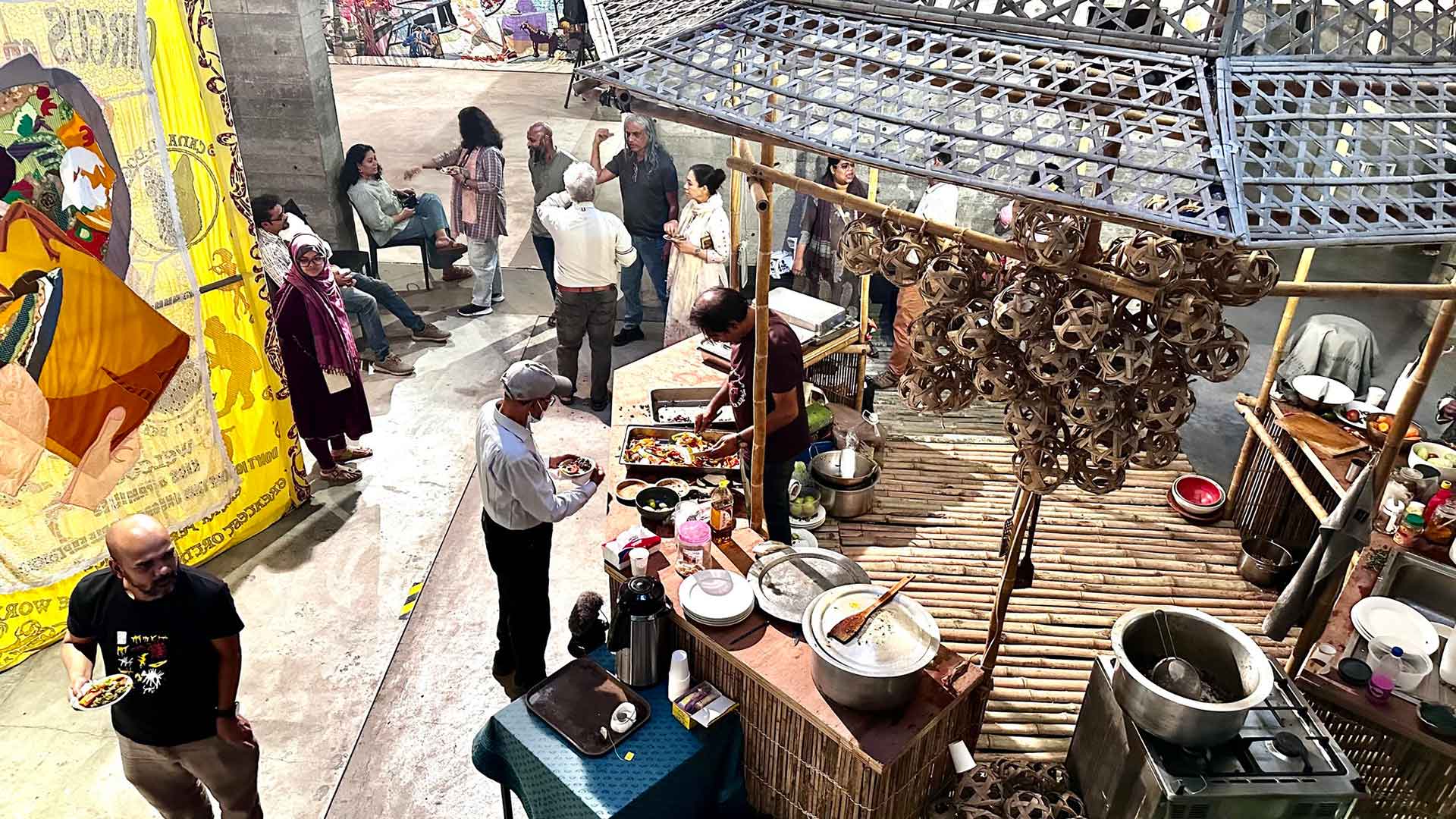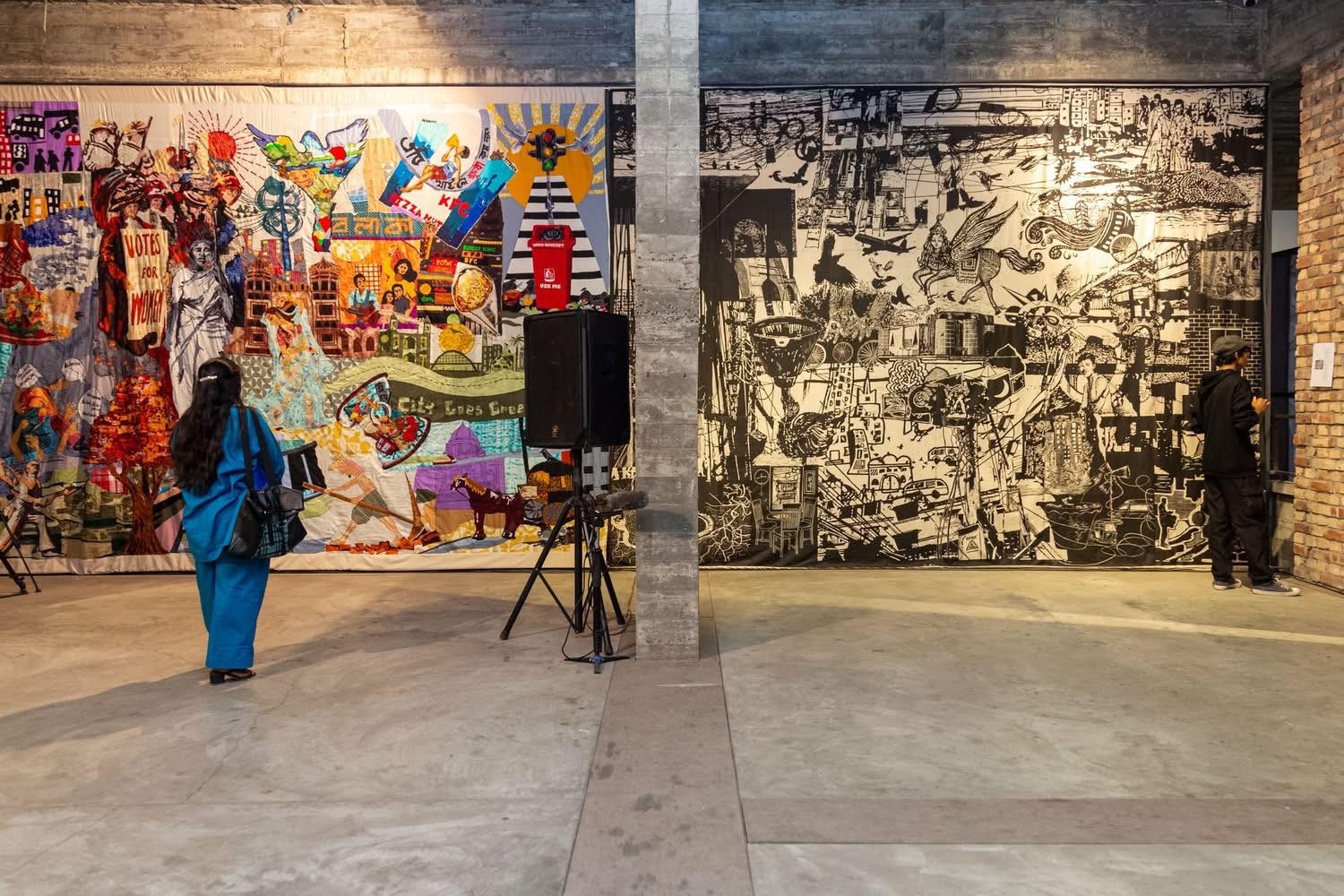Curating and Re‑public / Re‑commons
Amid the swift currents of life, we rarely pause to gather the quiet echoes — the stories of our change, endurance, the vivid remembrance of past journeys, and the soft pulse of our belongingness. With each passing layer of time there is a light that falls upon our pathways and suddenly we feel a new narrative starting to unfold.
It starts when the light brushes against the absence. And between illumination and stillness, lies a world where art becomes the medium of wisdom, lifestyle, and the collective memory of time. It is an invisible and imaginative arena that is devoid of loud declarations, rather having a delicate whisper. And in these fragile pauses, when we reconnect with the relationship with ourselves, new meanings emerge and the light of art finds a powerful voice.
Introduction
This narrative opens up the avenue to look again toward the unseen edges of urban life, the forgotten urban fabrics, colorful margins, and cultural landscapes. This is to find the ways of how silent voices find artistic forms that disclose new dimensions in our present fragmented society. In a world where communal desires are often broken up by the pressing demands of individual urban identity, there is still an awareness that holds the residue of human experiences. This perception still gives us a chance to meet the harmonic point, so as to create a shared and collective identity, eventually giving birth to a new cultural identity. To open up this idea even more, the whole Shohornama project1 explored the layers of hidden stories, often overlooked in the city, among the intersections of the displaced communal memories. Artistic journeys are conceived in order to find a common ground through visual arts, installations, and performances. Dhaka is changing rapidly; the old ways are getting erased and new ways of life are arising every day. In Shohornama, the kind acts of sharing stories, memories, and creative endeavors have become the way of reclaiming space in Dhaka, a city that often forgets its own heritage. The new cultural identity slowly introduces itself as a quiet form of resistance against the constant process of urban erasure, and starts to celebrate the lost connections despite their inevitable displacement.
These ideas are framed through the lens of the Glimmer of Artistic Topographies, with its raising of the question of the genesis of a city, the idea of living in togetherness. It slowly starts to explore how seemingly the peripheral spaces and the communities hold the power of transformative social narratives that may redefine urban thresholds in a more meaningful manner.
Rooted deeply in the unseen narratives and artistic imagination, the journey opens new paths of interconnected conceptual threads drawn from various disciplines, featuring exhibitions, conversations, and social engagements. All of these focus on the current processes of the overwhelming expansion of our city, and question the system of centralized economy in return.
Through adaptable, spontaneous, and community driven creations, all these attempts give heart and scope to redefining the search for more inclusive cultural identities.
Britto Arts Trust: A Shared Place of Making and Thinking
This phase of the ShohorNama 2.0 project grew out of a long commitment and a layered process of research, field engagement, and collective creation—coordinated and supported by Britto Arts Trust, whose role was to enable the process rather than impose preconceived ideas. Initiated as a process-based and organically collaborative thinking, Britto facilitated a flexible platform where a wide range of practitioners—artists, architects, performers, designers, artisans, and even local craftspeople—could come together to shape the project in response to site-specific realities.
What started as a loose conceptual inquiry into urban transformation gradually took shape through conversations, shared meals, fabric experiments, bamboo structures and collaborative fieldwork. Every element, be it a community kitchen, a soft sculptural form or a performance, was created with care, skill, labor and local knowledge. This intersection of creative thought and manual craft is what made the process both inclusive and grounded for all.
Rather than rushing toward a finished exhibition, the team embraced slowness and experimentation. Time was given for building trust with communities, navigating uncertainty and allowing ideas to evolve in response to place. Whether stitching fabric in The Big Tent, erecting bamboo frames as a playscape, or designing ephemeral structures in NEER, the process always involved shared authorship, where the boundaries between artist and artisan often blurred.
In this way, the entire journey departed from any singular idea or curatorial vision. Instead, it was shaped by a collective process—formed by many voices, experiences, and minds working together across diverse sites and contexts. Britto’s role was to hold space for this complexity to unfold, logistically, emotionally and artistically. The result is a body of work that holds its place firmly within a gallery while also carrying the imprint of the city, the village communal kitchen, the layered narratives, and the conversations in between. This is not just an art project. It is a statement about how things are made, together.
Key Themes/ Layers of the Research
01. The Margins of Living Archives
Like the forgotten pages of a book, and with a pursuit of finding gaps between urban margins, there remain the stories of endurance and quiet rebellion—hidden beneath the shadows of glass towers and sprawling highways. These gaps/layers cannot be termed as mere urban voids; rather they constitute the living archives of struggle, adaptation, and hope.
How are these stories embedded in marginalized spaces, and how do they reshape the cultural identities of a rapidly urbanized city like Dhaka? This process can start by planting the seed of an idea for creating a space from a very personal memory, which can then become a communal place for all. Like imagining a tale of a displaced caravan of craftsmen or artisans, they weave threads of their memories into industrial fabrics, stitching together their past and their present, along with dreams of their community. They are trying their best to capture the essence of their survival, revealing a shared space for a new beginning.
“Big Tent”—A Shelter Between Worlds can be experienced with a sense of permeable existence, where the past, present, and future of identities becomes a blur. The tent is more than a structure, it’s a gesture. Through art and shared memory, the layers of the tent are given shape — becoming stories waiting to be told in the language of light. The tent can be felt, heard, and experienced with the fleeting movement of light, with the whispers of the breeze. It stands in quiet defiance of permanence, bending to the rhythms of those who journey across the shifting landscapes. For centuries, nomadic communities have carried their lives beneath its fragile canopy, crafting a dream not bound by walls but by the promise of freedom.
Throughout history, the tent has held the makers of empires and their dreams. The Mughals2 ruled beneath its ornate fabric, weaving power with transience. In the deserts of Arabia, tents became homes that held not just bodies but entire worlds — binding the layered memories of culture to a life in motion.
It speaks of a borderless world wherein people follow the pull of the earth and sky, seeking places where life may root, if only for a while. They retain energy with the sunrise and share the tales of ancient times under a starry night sky. It is a place for the generations to pass on these artistic ways of living. Yet, with every crossing comes tension. Every now and then the boundaries are hardened, and the fluid grace of mobility meets the weight of laws, taxes, and systems eager to fix what is meant to move. The tent, unclaimed by these rigid structures, slips through the grasp of regulations determining the concept of the city—unpatented, uncontained, and unparalleled.
But movement leaves its own kind of enlivening silence. As people cross lands, their identities blur, becoming both present and unseen. A sacred ground for the seeker to reach out for the forgotten archive of communal thinking. For communities like the Santals3, and others who live between places, the act of moving is also an act of disappearing: traces of their lives are often lost in the folds of modern systems that fail to recognize what cannot be neatly defined and documented. Perhaps this is the nature of a big tent, an ever-changing, free flowing entity that wants to live past the regular domain of civilization. Over time it wants to become a transition point where life can move freely, like a bird that migrates without the tension of a border. Surviving across time, these simple shelters remain a symbol of a life unmoored, where belonging is not rooted in the given land, but in the shared memory of movement itself.
The Applique works of Big Tent visually translate the themes of nomadism, time – culture, impermanence, and shared identity. In Up in the Monolith by Artist Mahmuda Siddika, she explores the concept of a simple lifestyle, shifting memories, and the cultural economies of the city. Her delicate craft searches for the rationale behind thousands of people’s livelihoods and their relentless movements to belong. Stitching together fragments of fabrics, the layered work mirrors the blend of varieties, cultures, accents, foods, and the list goes on. This strong construct, interwoven with the narrative of a chicken curry, crafted with rough, earth-toned fabrics, evokes the duality of human capacity and luxury. Her work transforms the cloth into living memory, soft yet unyielding.
02. Elemental Memory & Pulse of the Earth
Thinking begins by seeing, and seeing beyond the surfaces of this realm begins by dissolving the illusion of a separate “self,” and accessing a more profound level of understanding beyond thoughts and emotions. Materials speak —not with words, but with the quiet weight of memory. Every surface of this earth holds a story. Wood remembers the forests it once belonged to, its grain still carrying the lullaby of the wind. Stone hums with the echoes of ancient earth, shaped by time’s slow, patient hand. The fertile land, once green and scenic, is now worn and frayed, yet holds the warmth of hands that stitched it together —a trace of those who once called it home.
Bamboo; a material traditionally valued for its strength, flexibility, and rapid growth, naturally embodies endurance. Throughout Shohornama, material choices are never neutral, they connect to the histories of survival and renewal. In Pakghor (community kitchen project) the bamboo structures rise modestly yet with a pride, demonstrating that spaces can be built with earth’s gifts. The lightweight structures and installations of bamboo make the exhibition more grounded in terms of material memories, mobility, and reformation. Through these forms, Shohornama honors the ingenuity of communal spirit while exploring the versatility of a material retelling us the crafted narrative of new spaces of belongingness.
By exploring the elemental memories, we dive deep and start to understand the imprint of touch, the breath of labor, the passage of lives unseen. In the textures and fractures, we can uncover the trails of ecological and cultural lifelines of a place — what has been taken, what remains, and what is at risk of being lost forever.
They are not passive; they bear witness. If you listen closely, you will hear the stories hidden in their folds, breathing softly beneath the forgotten winds of time.
How can reimagining elemental memories and their life cycles inform and transform sustainable and culturally rooted design practice?
A city, although it can be described and accessed within a physical parameter, exercises the grasp of changing a distant, fertile, virgin landscape drastically, with the claws of established economy and political injustice. Once an untouched forest with a river, its inhabitants now breathe heavily in sorrow as the city changes the course of their lives with its driving economic pressure. The soil still recalls the days when the rich earth nurtured the generations of fishermen, farmers, and protectors, their ways of life yet echoing in the heavy air.
“Neer” — Where Spaces Speak. Though revolving around the idea of a shelter for the flood affected people of southern Bangladesh, this installation has gradually become a poetic journey of architectural thinking and expressions, as well as a visual storytelling of artistic topographies.
Originally a Bengali name, Neer means the subtle symbol of a home. It sheds light on the rebuilding of the human spirit in the collective approach, wrought in the domain of community design practices while archiving the essence of a real landscape in more artistic ways.
Architects do more than shape the visible — they give form to ideas, blending stories into the spaces we inhabit. Their designs respond to the pulse of a place, echoing its rhythms and silences. Within the gallery’s quiet frame, these visions unfold —where lines and light collide, and the invisible becomes seen. Here, architecture is far from only the notion of functional demography, it is a profound language toward the world we long to build that welcomes new ideas and reflects on new challenges. Each approach became a reflection of human experience — of movement, memory, and the delicate balance between presence and absence. It is a reflection on urban narratives, where the edges of the country hum with stories of loss, survival, and belonging. Like the ebb and flow of the Tide, the project carries the weight of what lingers and what fades, revealing the fragile dance between permanence and disappearance.
Through Neer, we sought to challenge conventional ideas of stability and permanence, offering new perspectives on sustainable living and adaptive architecture. These new concepts traced pathways to ecology, food security, and the restoration of the land, as well as stories of health crisis on the southern fringes, making each intervention an act of quiet resilience. Neer became more than an exhibition; it became a living, breathing space for unlearning the seductions of modernity, and a renewal for all.
In these shared acts of creation, there is a promise — a belief that communal practice can soften the harshness of societal and ecological displacement and carry forward the voices often drowned beneath the rising tides of progress. Through every design and intervention, the project remains a testament to the power of spatial dynamics; — not only to shelter, but to hold the unspoken, the unseen, and the stories waiting to be told.
The project titled as Neer, by Architect Kazi Sydul Karim Tuso, transcends the regular static volume of a gallery space, turning it into a soft, floating, shape of memories. These memories harken to places forever in touch with rising sea water. Through suspended bamboo roofs and waste yarn threads cascading like silent floods, Neer evokes the slow, unseen forces of climate migration. The bamboo, a humble yet enduring material, speaks of histories of struggles for shelter, where falling yarns embody fragile hope. The installation invites us to walk in the path of uncertainty with a flicker of hope in our hearts. It also shows that to respond to a shifting world, we must not only design buildings, but nurture spaces where empathy, grief, and imagination can co-exist.
03. Threads of Connectivity: Beyond Political Periphery
Political spheres of a city are usually being controlled by established urban layers and designated historic places. They express an original and most importantly unique political heritage and characteristics. The political system’s dynamic exposure influences the very lifespan of a country. Gradually, the political periphery becomes a space of new meeting points, stories of migration, and survival, where creativity intersects with new cultural ideas. The layers of a city are the bridges, connecting the forgotten values to be celebrated once again, making the local political identity move towards a global identity.
How do certain artistic practices explore and amplify the communal political voices of the city dwellers, creating a new dialogue of connections within urban centers and the freedom of voices?
A young girl from a displaced community like the circus, starts painting her dreams of home, her hopes, on the walls of an abandoned factory or a defunct industry — her art transforming decay into hope. A belief in an imaginary society, a free world without chains, inspires her vision.
“Dorjikhana”: Unraveling Power, Fabricating Resistance gives an evolving and lasting experience of a space where the familiar textures of fabric intertwine with the urgent act of political position and questioning. Through textile-based artworks and artistic collaborations, it invites both makers and viewers to reflect on the hidden forces shaping our world. At its core, the project uses the metaphor of the circus — a fading yet spectacle-driven narrative rooted in the land — to examine the fragile balance between performance, power, and control.
In a world where power often operates through illusion, Dorjikhana uses the circus as a lens to reveal what is hidden and trapped: the labor behind the spectacle, the bodies that sustain economies, and the stories that refuse to disappear. Through every stitch and thread, the project asks us to look beyond the colorful surface, challenging us to imagine a world where injustice is not masked by performance but laid bare for all to see, so as to raise an inner voice of resistance.
The circus, with its dazzling illusions and carefully staged acts, mirrors the machinery of political power and societal advocacy. The artists in Dorjikhana expose these unseen dynamics, reinterpreting circus imagery to challenge systems of authority and hidden exploitation. Beneath the bright colors and playful motifs lies a more serious reflection: who holds power, and who performs for survival in return? What truth fades beneath these spectacles?
Through appliqué, embroidery, and other fabric-based artworks, the artists reinterpret circus iconography in new and subversive ways that speak for justice. Some works invoke the image of the performer — bending, balancing, always on display — while others unravel the political structures that hold these spectacles together. The tent, for instance, becomes both a site of shelter and a symbol of precariousness, reflecting the instability and empathy towards those living under political and economic oppression.
This inquiry is embedded in the wisdom of the materials themselves. The project is intimately tied to Bangladesh’s garment industry, where textile production reflects our broader social and economic inequities, and also reconnects us with the histories of fabric war. The mobility and accessibility of fabric become symbols of both freedom and constraint, echoing the lives of the laborers who sustain global markets yet remain invisible within the realm. By working with fabric, the artists engage with the politics of labor, revealing the tension between creation and exploitation, visibility and erasure.
More likely to be felt as a cosmic order in fabric, Artist Shyamal Datta’s The Divine Blueprint transforms the language of textiles into a meditation on cosmic cycles. It stands as a token of reverence to the knowledge of ancient cosmology while becoming a bold expression of the divine consciousness of our universe in motion. The work slowly reconnects today’s fragile world with the realm of wisdom. Using layers of fabrics, in appliqué and stitching, the artist reconstructs the universe as a living pattern, where elements become more than a textile design. His works also resonate with Dorjikhana’s philosophy; fabric being the element of both political memory and the new possibility to express artistic freedom. In a world facing political injustice and environmental collapse, this work becomes a quiet reminder suggesting that even as forms dissolve and worlds collide, the essential blueprints of universal consciousness remain, waiting to be reborn.
04. Endurance Through Co-creation
Communities; in any part of our world, will always thrive when they are given a chance to recollect inner belief and strength. The positivity of a communal spirit takes us to another dimension, enabling us to have the agency to share stories and empowering the reshaping of space. By helping each other to co-exist, we move beyond our comfort zone to blur the traditional border and work effortlessly to achieve a shared ownership.
What participatory methods can ensure inclusive views, and how can artistic practice rethink the ways to reflect on the critical needs and aspirations of a society/community?
In the heart of a broken landscape, a community kitchen gathers every piece of strength to rebuild the future. It opens up the window in a heavy storm in order to look forward for the collective hope — a shared tomorrow.
“Pakghor” — Nourishment of Spirits, Rebuilding Lives is a simple community-based social kitchen concept that transcends its regular parameters. Born from the urgent need to respond to the devastating floods in Bangladesh, Pakghor emerged as more than just a community kitchen —it became a space where survival met solidarity, and where shared meals and chit-chats became a catalyst for healing and rebuilding the broken landscapes.
In 2024, as floodwaters engulfed regions like Horinkhola, Polder22, in Khulna, destroying the houses and displacing thousands, the absence of home-cooked meals and drinking water became a profound loss. Amid the chaos of temporary roadside shelters and dry food aid, the warmth of a freshly prepared meal became a symbol of care and community.
Pakghor was thus installed —a kitchen not only to provide nourishment but also to restore a sense of home and dignity. For a week, villagers gathered to cook and share one warm meal for 500 people, the simple act of a powerful gesture of collective resilience. Within the aroma of familiar spices and the rhythm of shared labor, the community found a way to reclaim what the flood had taken: the comfort of their kitchens and the strength of their bonds.
But Pakghor became something larger — a living archive of shared knowledge and survival practices. As pots simmered and hands worked together, stories unfolded. Villagers exchanged traditional wisdom about food preservation, sustainable farming, and ways to rebuild homes with limited resources. This collective memory of co-creation, passed from one hand to another, became a form of endurance against the erasure caused by disaster.
The project’s vision extended beyond immediate relief. A team of architects and researchers joined the initiative, addressing critical needs like housing solutions, food security, moral upliftment, clean water access, and livelihood restoration. Their collaboration turned the community kitchen into an experimental, interactive space for long-term sustainability. Together with local knowledge, they sought practical solutions rooted in the realities of the people affected, searching for ideas that could withstand future floods and exploring sustainable ways to secure local livelihoods. All of these actions resulted in collective expressions like reusable building materials, Playscape, ecological balance, and a poetic experience for city people.
Pakghor’s essence lies not just in providing meals but in fostering community-led resilience. It is a reminder of the established urban idea, that shared food is more than sustenance: it is a memory, a bond, and a tool for rebuilding what has been lost. In the heart of a disaster-stricken region, Pakghor became a temporary symbol of home, one not made of walls, but of people coming together to cook, share, and imagine new possibilities for their future, ready to face the storm.
That is exactly what happened in these two spaces involving two forms of healing. In Horinkhola – Polder 22, a Pakghor rose from the water. A fragile, temporary kitchen where flood-stricken villagers not only found a meal, but the first step toward community healing. It was a space of rebuilding lives, by offering comfort, dignity, and recovery. At Bengal Shilpalay, the Pakghor became more vital and a louder space for the gathering of all, after the July ’24 political regime change. The big gatherings created a safe place to vent out the trauma over a meal cooked in the central space of the exhibition. It was more than just a visual art experience. The warmth of freshly cooked meals softened the sharp edges of urban collective grief. The gesture of sharing a meal, music, and laughter made everyone resist the memories of the unrest time for a while. It gave us a window to see beyond and imagine new forms of solidarity. In political instability and natural collapse, both Pakghor installations, shaped by their own wounds, show how simple acts of kindness and sharing can seed endurance across very different topographies. They are testaments of quiet promises of beginning again.
To rebuild a community, we begin by sharing what nourishes the soul.
05. Preserving the Invisible: Memory of Urban Topographies and Belongingness
Memory of this current timelapse is fragile, yet precious, like a cotton thread in a bowl of water. The collective memory layers are the foundation of our sense of belongingness and points of new conversations for living in these urban areas. Artistic interventions and new interpretations have the power to preserve and reimagine these quiet stories. Artists are continuously thinking in the process of transforming spaces according to the new urban topographies. This process gives birth to new visuals, performances, and spatial designs that archive and celebrate the present while embracing change.
How can new forms of collective movements and stories of hope expressed through the elements of art and architecture ensure that cultural memory is being preserved? How can we rethink the erasure of our unique narratives in response to the rapid expansion of city and urban transformation?
Maybe a regular canvasser taking his familiar strolls in his alleyways suddenly sees the disappeared tree that once stood there at the edge of the city. He collects the remaining dried leaves in despair while looking at the horizon, only to witness the birth of a few apartment buildings sprawled in the once open field. His sorrow is for the unplanned progress of urban life with its flashy features. Yet the essence of the fallen tree can be felt inside and may be transmitted in our visual narratives, creating a new canvas of recollection for enlivening human spirits.
“ShohorNama 2.0” —A Layered Narrative of Humanity & Connection is a collection of experiences of visual art, installations, performances, and inclusive social kitchen initiatives, all helping to redefine urban narratives through art that speaks to our humanity. The whole journey became an intersection point for the people belonging to different classes to join in an active, happening, artistic landscape.
Originally envisioned on a much larger scale, ShohorNama evolved in response to the challenges of its time. Political and societal constraints called for a more modest execution, but the spirit of the project remained intact. It has been driven by a belief in the transformative power of art to reflect, question, and reconnect us to our former and present experiences. In collaboration with several artists, architects, researchers, and institutions — including the Faculty of Fine Arts at the University of Dhaka — the project became a shared creative space where students, teachers, and artists converged to explore the city’s changing identity. A meeting point of new ideas where individual desires became a part of a whole communal experience. ShohorNama spoke for the unseen, unheard voices in the current society.
The rapid transformation of Dhaka is a story told in shifting skylines and changing lives. Over the years, waves of migration have carried people from rural landscapes into the city’s dense core, drawn by the promise of false opportunity. Yet, beneath the surface of shaded progress lies a more complex, harsh reality — one where social and political tensions press against the ever-expanding urban margin. The new economic classification of people affects their choices of survival in this city. It is within this dynamic and often overwhelming context that ShohorNama was conceived — a project that seeks to give voice to these evolving urban narratives through collaborative artistic expression. A way to rethink the layers of urban fabrics, social disparity, and city’s disappearing natural ecology and landscape. At its heart, ShohorNama is a celebration of visual storytelling — where personal narratives, collective memory, and artistic expression intertwine. Within this framework, images are not static representations but fluid expressions of movement, shadow, light, and emotion. The creative process invites participants to blend their individual experiences into a collective vision, much like the merging of air and water — distinct, yet inseparable. Over the course of a week, these fragments of personal reflection and artistic exploration merge into a unified artwork, embodying the power of collaboration of different identities and giving birth to a realm of shared creativity.
Beyond its artistic ambitions, ShohorNama is rooted in a deeper exploration of societal conditions and human endurance. It reflects on how individuals navigate the complexities of urban life, societal pressures, and the enduring impact of natural disasters. The immersive experience brings attention to the human cost of urban migration — those whose lives are reshaped by forces beyond their control. Central to this inquiry is the notion of gender respect, addressing how gendered experiences shape urban existence and how artistic expression can challenge and reframe these realities. Shohornama sheds light on the effect of social media’s influences on gender issues and how it is transforming gender roleplay in the society.
More than just an art project, ShohorNama aspires to bring humanity closer to art, using creative expression as a bridge between individual stories and inclusive experience. It offers a pedagogical space where students and artists push the boundaries of traditional practice through fostering confidence, empathy, and a broader creative vision. By exploring new dimensions of artistic thoughts and new media, the project nurtures an understanding that art is not isolated from the world, is not merely a piece to be showcased in an esteemed gallery anymore, but is deeply rooted, intertwined with the lives and struggles of those who create it. Art has become a story to be shared, a cultural landscape of an imaginative world, and a disclosure of the unconscious desires influencing all human beings.
In its essence, ShohorNama is an evolving narrative. It speaks to the shifting landscapes of Dhaka and the human spirit’s ability to endure, and adapt, finding a new meaning of life itself. It is a reminder that art is not only a reflection of society, but is also a means to reshape how we see, feel, and recollect, in response to the ever-changing echoes of our world.
Research Objectives
- To see and raise voices on the ongoing environmental crisis, rapid urbanization, political repression, and societal injustices that are reshaping our future, and finding a light of hope towards a balanced, humane world.
- To develop and implement the participatory artistic frameworks for social inclusion, emphasizing the processes of co-creation among multidisciplined communities.
- To explore the fading narratives of urban peripheries, searching for the seed to catalyze the creative thinking process that archives the ongoing cultural endurance and innovation. The simple acts of spontaneity of common people open us to the imaginative world and the unconscious desire of humanity.
- To investigate the ecological narratives which are embedded under the new layers of urban sprawl — that still speak of heritage, materiality, and social engagement.
- To examine the role of critical thinking in preserving originality and collective cultural memory and its role in fostering a global identity in urban spheres. To create a space in which to talk about and question the effects of industrial production, waste cycles, and their socio – political impacts.
Methodology
- Interviews based on story driven fieldwork, documentation recording the responses of artisans, craftsmen, and community members on the topics of displacement, endurance, and hope.
- Workshops and co-creation activities in the organized sessions, wherein the participants collaborate on site-specific artworks, installations, or spatial interventions.
- Material storytelling and mapping organized in order to understand and practice new media art, so as to speak about the use and life cycles of materials that can be introduced in the field of creativity.
- Case studies of marginalized communities on our urban fringes, collected to become the very core subject matter in terms of visual expressions that address the hidden interplay between urban layers and the archiving of this fluid phenomena.
- Art displayed as a narrative medium engaging audiences in terms of immersive experience. Visual art, Soft Sculptures, Performances, Social activations, Workshops, Conversations, and Video installations, all helping to communicate research findings, ensuring an emotional resonance with the diverse audiences.
Expected Outcomes
- New forms of spatial concepts, prototypes, visual narratives, that reflect our cultural endurance, ecological sustainability, and communal agency.
- A digital and physical repository and publications of the present community stories, material-heritage, artistic endeavors and preservation of cultural topographic memories.
- Public engagement models that help to describe the frameworks of social inclusion and participatory methods that empower communal voices through art and design practices.
- Policy on the expansion of cities exploring insights that may help to understand how cities can integrate positive, cognitive, inclusive cultural practices into future urban planning for growth.
- Creative outputs on visual art, new media practices, installations, exhibition curatorial studies, performances, and social participations, intended to bring this research together as a connecting place of our fading landscapes and invisible stories.
Critical Points for Creative Thinking
- New formation of Design: Adapting to a Changing world; can this emphasize:
- Creative practitioners’ roles in relation to the real-world crises in socio-political displacement, climate change, and migration?
- A balanced ground of ongoing traditional thinking and technology powered models?
- Shared ownership and accessible urban spaces.
- Questioning rooted cultural identity in juxtaposition with the forces of an ongoing modernity, in rethinking the design process.
- Ecological narratives and material heritage in terms of a new social responsibility.
- Communal voice and Co-creation.
- Recovering the essence of ancestral ways and the introduction of digital tools.
- Ethics, practice, influencing the realm of political dynamics in the urban space.
- Designers as the agents of Social Change.
- Interdisciplinary or Multidisciplinary approaches in artistic practice.
- Process of archival methods and incorporation of fragmented narratives.
Body; The Sacred Sanctuary
In a time wherein social and political ideologies are getting heavily restructured, performing in public places opens an area for interactions, producing meaningful shifts within our shared spaces. It demonstrates the idea that a public space becomes enlivened when it is socially performed. The practice of performance art offers a flexible and innovative environment to artistically question, redefine, and sometimes help to reclaim a social space in a broader sense.
To move, to dance, to resist— to simply be— is the most profound act of courage and survival. Even when everything else is taken— our land, homes, even our language, our spirit remains. It is the last territory that can’t be conquered, the final stronghold of our existence. Our body harnesses the inner spirit and through performance art we don’t just simply remember, we start to reclaim the emptiness, we start to remake the lost world.
The body waits for nothing, no permissions; it carries its own architecture, shifting between barriers, between loss and reconciliation. Across civilizations and history, performance art has been the language of the displaced.
In Shohornama 2.0, the intricate and delicate performance art has captured the essence which is deeply rooted in the layers of our ephemeral world. Hence, it becomes an instrument of voices enabling survival and transformation. The performances were not merely an aesthetic addition; rather they created a living dialogue between past and present, between the seen and the unseen. Inhabiting this art form made visible the tension points which are reshaping the contemporary culture of Bangladesh. They have raised voices testifying on the context of displacement and ecological disaster.
How can the body respond to the city’s shifting topographies— giving birth to a counter narrative opposed to the relentless expansion of concrete, industry, and environmental disasters? How can the collective narration of bodily responses help us to hear the cry of the forest calling out to the displaced communities?
The meaningful artistic explorations of performances in Shohornama have articulated the struggles of those who are often unheard. They gave voice to the voiceless. They have exposed how progress and destruction walk side by side— how deforestation feeds developments. They reveal how the political powers are mandating forced migration, thus creating new, invisible populations, and how ethnic-cultural cleansing is masked as the act of modernization.
Stretching from the ancient vessel of communal storytelling, such as Puthi recitation, to the act of sharing a cooked meal, they boldly questioned the so-called economic system which determines who gets to stay and who must leave. These performances have disrupted, unsettled, and finally challenged the notion of the static white cube exhibition space. They have blurred the unseen boundaries between the artists and the audiences, allowing them to become one unified movement of human endurance. In movement, in voice, in ritual, the artists have inscribed the realities, the modern-day struggles, the questioned faith, and the power of human endurance. They have transformed a static exhibition space into the living alter of flesh and breath — a place where the cry of mother nature can’t be ignored, where history can’t be erased, and the resistance can’t be silenced.
Performances Highlights of Shohornama 2.0
Among the topics ranging across ecological loss, food politics, urban alienation, cultural memory, and endless consumerism, the performance art’s expressions have mirrored the layers of the city itself. All the works were interconnected in some manner. Whereas one mourned about the silencing of nature in the face of rapid urbanization, other works exposed the politics of urban diet, forced migration, and indigenous survival.
Sharad Das_ Lamentation: Sharad Das’s performance art is a poignant reflection on humanity’s fractured relationship with nature. His work embodies grief for lost landscapes, by using his body as a site of rupture symbolizing the struggle between nature and human ambitions. Through movement and material interactions, he recreates the slow destruction of ecosystems, urging viewers to reconsider their relationship with the earth. His work challenges modern knowledge systems that often overlook the wisdom of natural coexistence, exposing the contradictions between development and sustainability. Through his body, Das enacts a dialogue of silent resistance— his movements mirroring the fading vitality of landscapes lost to urban expansion, his voice resonating with the silent cries of felled trees and displaced birds.
His performance becomes an act of mourning and reckoning, a reminder that nature is not a passive backdrop to human existence but an intertwined force that demands respect and renewal, emphasizing the urgency of restoring the lost harmony.
Jayatu Chakma & Joydeb Roaza_ Food & Cultural Erasure: The collaborative performance of these two artists sheds light on the critical factors working behind colonial and contemporary politics that shape food accessibility, indigenous agricultural practices, and the loss of an ancient self- sustaining knowledge system. In witnessing this performance, the audience realizes that food is not only a substance to be gorged upon, it is a symbol of the wisdom of the land. The performance examines how modernization becomes a trap, erasing traditional food habits and ancestral knowledge from human life. Yet, our memories remain connected to our culture— our bodies and minds standing as symbols of more ancient foodways and practices. Also, both artists reclaim these vanishing traditions by incorporating unknown ingredients and green vegetables, referencing recipes used in ancestral rituals and ceremonies. Through this act, they challenged the dominance of industrial food systems, urging audiences to recognize the deeper cultural and spiritual significance of food.
Tahmina Hafiz Lisa_ I have Lost a city: “In this city, I am searching for a city, searching for a time,” Lisa proclaimed, embodying the longing for lost spaces and forgotten narratives. Her performance navigates the themes of displacement, memory and belonging in an ever- transforming urban landscape. Her work reflects on the erasure of histories and identities within the expanding city, where modernization often uproots both people and traditions. Through her performance, Lisa reconstructs fragments of memory, evoking a sense of disorientation and embodying herself as the edifice of resistance, preserving stories and voices that might otherwise fade into the city’s relentless evolution.
How Performance Art enriched Shohornama 2.0
- Challenging the power plays— The body of artistic expressions exposed the power game of the “City” in both layers: as a dream, and as a machine. It illustrates how the city constructs and destroys, welcomes and displaces, nurtures and alienates.
- Reclaiming Traditions— Using Puthi, the living form of storytelling and indigenous food culture, the artists connect and question the transformation of cultural knowledge systems and as well as the ubiquity of industrialized diets.
- An urgent call — The amplified voice of the artists made the abstract issues tangible. Deforestation, forced migration, consumerism, societal injustice, rapid urban growth; all these pressing issues are felt, not just discussed in a talk.
- Space Transformed—The performances interacted with the exhibition’s area, involving the exhibits and installations, so as to create a multi-sensory experience. Sometimes the exhibits are the backdrops, yet at other times becoming the center of artistic endeavors. Even the cutleries of the Pakghor became instruments for performing songs and melodies.
- The performance art has been a critical medium of storytelling, protest, and self- reflection. The performances broadly addressed ecological loss, forced displacement, societal disparity, cultural erasure, and the consequences of rapid urbanization. They enacted a blend of contemporary artistic expressions, deeply rooted in our historic and traditional forms.
Conclusion
Margins/Fabrics in a city are often termed as the overlooked spaces that pulse with hidden cultural narratives and local ingenuity. The exploration of wisdom in the lifestyles and the handling of the daily crisis for survival opens our vision toward a new global connection. These unforeseen layers embody adaptive strength and hold the secrets of relentless pursuit useful for continuing the creation of new artistic endeavors. Art happens when light touches the invisible surfaces and illuminates open spaces conducive to sharing our ideas. It offers a fertile ground for innovations and communal practice. By reimagining these covert layers, our city can embrace change and celebrate diversity, foster inclusiveness by transforming overlooked social practices into vibrant, dynamic, cultural purposes. Creating a meaningful dialogue and healing the relationships among ourselves is essential to bringing forth much-needed societal changes.
Open minds can create an open space. Along with this notion in our present time, Art is breaking the boundaries of modernism and is being transformed like a seed in an embryo, one that needs continuous nurturing and care. Only then it can give birth to a new beginning of the human condition and thus enhance our living interconnections. It is teaching us to accept anything and anyone, so that we can rebuild humanity.
This research narrative draws strength from the birth of artistic imagination, ecological consciousness, socio-political views, and lastly, endurance of the human spirit on the brink of crisis and suffering from hardships for survival amid the chaos. By stitching together all the threads like in an appliqué canvas, we discover how the glimmer of artistic topographies and imagination aim to redefine, to reimagine our cities as one shared landscape and a ground for collective memory. The goal is to actively participate in the process of the ever-changing nature of urban topography through art, activism, critical thinking, and inclusive cultural practices. Let the genesis of new artistic landscapes nourish us into being the dreamers of a compassionate and empathetic society.
1 Peter Galison describes how perception of time changed during the industrial revolution in his book Einstein’s Clocks, Poincaré’s Maps – Empires of Time, New York: W.W. Norton, 2003. He frames how the invention of universal time is the beginning of the mathematisation of the world.
2 Miya Yoshida, “Can You See the Butterfly?” in Den Steinen zuhören,Dresden: Kunsthaus Dresden, 2023; “Reformulating the Architectures of Exhibitions” in Curatography no. 10; Exhibition Amnesia, or the Apparatus of Speculative Curating, Taipei: Taipei National University of the Arts, Curating Asia International, 2023.
3 The Japanese term, Mimi o Sumasu, is a specific mode of listening, centring the body in your current space, tuning your ears to the phenomena, being attentive ubiquitously in all directions of your environment.
Share
Author
Shamim Ahmed Chowdhury’s work as a visual storyteller is deeply rooted in the exploration of cultural heritage, nature, and human experience. He seeks to capture the fleeting moments where tradition and modernity intersect, using a variety of mediums, including words, drawings, paintings, paper craft designs, and illustrations. Through his practice, Shamim aims to bring attention to stories and symbols that are often forgotten or overlooked, encouraging viewers to reflect on their own relationships with history, identity, and the displaced natural environment.
Shamim is particularly interested in how natural elements and contemporary narratives serve as carriers of collective cultural memory. His intention is to explore the idea that the natural world is an archive of wisdom, one that connects us to our past while guiding our present. By reimagining these cultural symbols, he strives to create a visual language that resonates with contemporary audiences while honoring the narratives that have shaped them.
Ultimately, his art is about fostering a dialogue between the past and the present, between the seen and the unseen, offering a space for reflection, connection, and reawakening.



